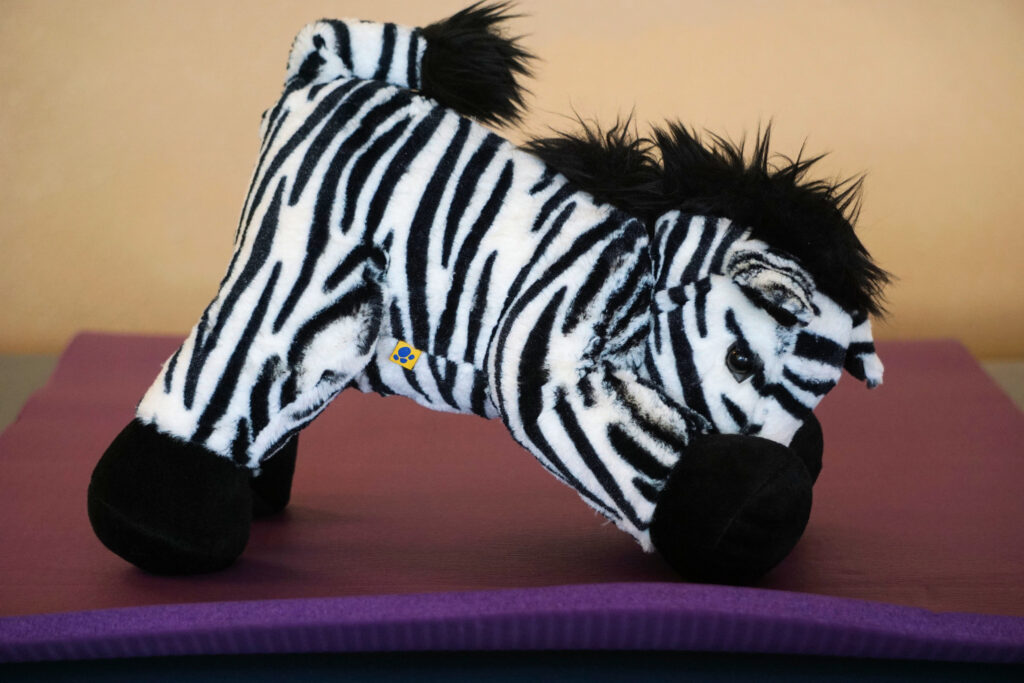2022.10.04
Yoga Zebras
Hello, Zeborah Dazzle, PT, WWF here. I am the spokes-zebra and patient educator for Good Health Physical Therapy and Wellness. In this post let’s consider a question that arises fairly often in our clinic:
Is yoga good for patients with hypermobility spectrum disorder (HSD) and hypermobile Ehlers Danlos Syndrome (hEDS)?
Many doctors who know some about HSD/hEDS will give the advice to never stretch. Included in this advice is to not do yoga. This can be confusing since stretching so often feels so good to us zebras, and, we are SO good at it.
All of us with HSD or hEDS know that it is a connective tissue disorder. Our connective tissues deform more easily and recoil back to their normal length more slowly. As a result, we are more prone to strains and sprains. And because our joints do not always have a clear endpoint to movement, this can affect our sense of where our bodies are in space (proprioception) affecting coordination and sometimes balance. Additionally, our loose connective tissues often hurt. Pain can feed back through the nervous system causing our muscles to lose strength and muscle tone. This along with the stretchy tissue puts us at risk of popping joints out of their best alignment (subluxation).
So, does all of this mean we should not do yoga? Not necessarily. Let’s first consider what yoga is for a moment. Yoga is more than just stretching. Yoga is an ancient Indian philosophy of self-awareness and self- exploration. Just one part of yoga is the practice of asanas, the practice of physical postures. There are many different approaches to asana practice, some fast and some slow, some stretching to the end of the range and some not, some more focused on meditation and some less. Some approaches to yoga will work well for people with HSD/hEDS and some not. I recently came across a new book by a physical therapist –Libby Hinsley, PT, DPT, C-IAYT — who has hEDS and is also a yoga teacher: Yoga for Bendy People, New Degree Press, ISBN 979-8-88504-118-8, copyright 2022. In this new book, Libby does a really good job of exploring the pros and cons of yoga. She writes:
In general, an asana practice that emphasizes mobility and performance is not likely to go as well… Extreme yoga postures may be fun from an acrobatic point of view, but in the context of yoga, I’m interested in the why. Why include the splits in your practice? What benefit does it bring, and how does it help you to reach your ultimate goals? Unless you are a circus performer, it’s not that useful. Life mostly happens in the mid-ranges, not at end ranges. Most of us aren’t training for the circus; we’re training for life. Pg. 94
I love this and agree with this. Hypermobile connective tissue does not need to be stretched hard to the end of the range for prolonged periods. In fact, more than one patient has come in and related that getting too competitive with their yoga stretching caused far worse problems even though it initially felt good.
Hard and competitive stretching is the big ‘no’ of yoga. What are the yeses?’
Yes to yoga used to explore. Yoga done slowly and consciously can open the practitioner to whole new levels of sensation from their body. And yoga done mindfully can help improve proprioceptive sense meaning improve coordination and balance. Yes to yoga done with awareness of breathing. Many with HSD/hEDS know that anxiety is a common companion condition. All of the reasons for this are not known. One suspected reason though is that the decreased clarity of sensation for end of joint ranges throughout the body becomes alarming to the nervous system and sets it on edge. This may lead to anxiety. Deep breathing and careful attention to postures combats the nervous system’s alarm. Yes to yoga in the mid-range. Postures held against gravity in the mid-range helps to build the stabilization around the joints.
It is always best to work with a yoga instructor who is certified and let them know about your condition when you start. After to this, the single most important rule to follow is this: if it hurts, stop. Do not let anyone push you in to an exercise that your body is telling you is wrong for you. Oh, and if you are looking for more information about this, check out Libby’s book. Let me know your thoughts on this subject in the comment section of our Facebook page. I hope soon to give you some previews of Heather Purdin’s upcoming book, Taming the Zebra. Until then, Cheers! Zebbie
Thanks to Dr. Mark Melecki, PT for his assistance in preparing this post.


